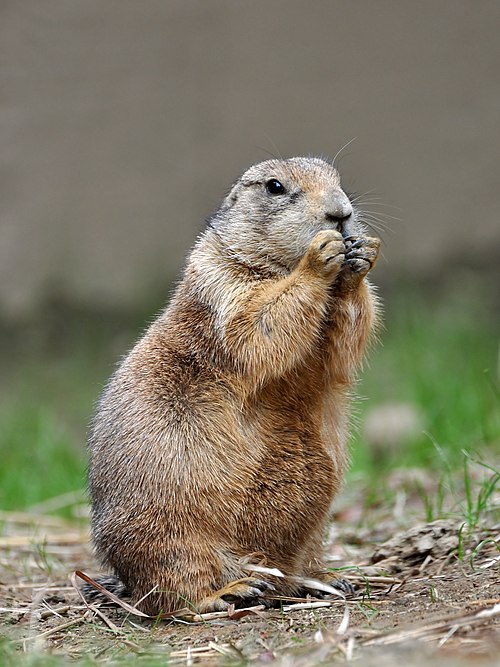Facts for Kids
Prairie dogs are social, burrowing rodents found in North American grasslands, known for their complex social structures and vocal communication.
Overview
Fun Facts
Diet And Foraging
Conservation Status
Cultural Significance
Predators And Threats
Habitat And Distribution
Reproduction And Life Cycle
Behavior And Social Structure

Inside this Article
Iucn Red List
United States
Great Plains
Community
Prairie
Disease
Spring
Year
Food
Did you know?
🐾 Prairie dogs are actually a type of ground squirrel found in North America.
🌱 They play a crucial role in their ecosystem by aerating the soil and helping grass growth.
🏡 Prairie dogs live in large colonies known as towns, which can cover hundreds of acres.
👂 They have a complex system of vocalizations that can convey specific messages to one another.
🍴 Prairie dogs are herbivores, primarily feeding on grasses, seeds, and roots.
👨🌾 Their burrows provide shelter not only for themselves but also for other species like burrowing owls.
⚠️ Prairie dog populations face threats from habitat loss and disease, resulting in significant declines in some areas.
🦴 Their teeth continuously grow, necessitating regular gnawing on hard materials to keep them worn down.
🌞 Prairie dogs are diurnal, being most active during the daylight hours.
💕 They demonstrate social behaviors, including grooming and playing, contributing to strong communal bonds.
Introduction
They belong to the squirrel family and are known for their cute appearance and social behavior. Prairie dogs have short, stout bodies, a bushy tail, and small ears. They can weigh between 1.5 to 3 pounds and grow to about 12 to 15 inches long. The name "prairie dog" comes from their bark-like calls that sound like a dog’s bark. There are five species of prairie dogs, including the black-tailed prairie dog, which is the most common.
Fun Facts
2. They can dig a burrow that is as deep as 3 feet! 🌍
3. Prairie dogs are always on the lookout for danger; they have excellent vision! 👀
4. Their colonies can contain thousands of individuals—some even have millions!
5. They can jump 3 feet into the air when excited or scared! 🐶
Diet And Foraging
They love munching on grasses, roots, and even some flowering plants. Their strong teeth help them nibble on tough plants. Prairie dogs spend a lot of their day foraging for food, often using their memorable burrows as a home base to eat in safety. They love to gather food to store it for the winter. As they eat, they unknowingly help the soil by spreading seeds, which helps plants grow again in the spring!
Conservation Status
The black-tailed prairie dog is considered a species of concern and is protected by law in certain areas. Conservation efforts are in place to help maintain their populations. Protecting their habitats and creating wildlife reserves are crucial for keeping their numbers stable. By supporting such efforts, we can help prairie dogs thrive in the wild and continue their essential role in our ecosystems!
Cultural Significance
️ They are often depicted in their stories and art. Additionally, prairie dogs have been featured in cartoons and movies, making them beloved characters for children everywhere! They are also popular with visitors to national parks like Wind Cave and Badlands National Park in South Dakota, where people can observe these lively creatures in their natural habitats. Learning about prairie dogs helps us appreciate the environment we all share!
Predators And Threats
To stay safe, prairie dogs take turns watching for danger while others eat. However, one of their biggest threats is habitat loss due to agriculture and urban development. Additionally, some people connect less positively with prairie dogs and may harm their colonies. The increasing spread of disease can also harm prairie dog populations. Because they play a vital role in the ecosystem, we need to protect them and their homes.
Habitat And Distribution
️ They dig extensive underground burrows in grassy areas, mostly found in the central United States, Canada, and Mexico. You can find them in states like Colorado, South Dakota, and Wyoming. Prairie dogs prefer open grasslands where they can easily spot predators and dig their burrows. Their burrows provide shelter from weather and predators, making them a safe home. They play an important role in their ecosystem by aerating the soil and providing habitats for other animals.
Reproduction And Life Cycle
They typically have three to five pups in a litter. The babies are born blind and hairless but grow quickly! Prairie dog pups stay in the burrow for about 6 weeks, learning from their parents before joining the rest of the colony. Young prairie dogs start to dig and play outside their burrows soon after. They reach adulthood in one year, and they can live up to 8 years in the wild!

